Snow in Amsterdam today.
Some blanketed Lavender…
A pretty and tasty Rose…
And some Ginkgo fruit, hanging on in the trees, even now…


Today a couple of useful pavement garden herbs:
Firstly, Rue (Ruta graveolens), useful in tiny amounts to help break down heavy meals, when cooked along with the food and a renowned witches herb (especially the Italian witches who favour jewellery, shaped like Rue leaves). Rue has many uses, due mainly to the volatile oils it produces. It should be treated with respect, both when handling the plant and when considering eating it. It is a very potent herb.
Next up today is Rose (Rosa sp.). A you can see, some Rose shrubs are still in bloom in Amsterdam. That means a few fresh petals can still be found to throw into ginger, cardamon and rose petal honey. Yum! Only select unsprayed roses from healthy plants, growing in clean spots.

Beautiful Roses, still in bloom and edible if unsprayed and growing in clean locations, here in Amsterdam.
Next is Russian Comfrey (NL: Smeerwortel, Symphytum uplandicum x) which I picked a leaf from today. Am currently brewing a tea from it ready to feed to my houseplants.
And lastly, the Park Warden blowing leaves from beneath the Lime tree avenue (NL:Linden, Tilia sp.) in Park Frankendael. Today seems to be Amsterdam leaf drop day, they are thick along the pavements and streets. Time to make the most of the beautiful autumn colours.

Beautiful autumn scenes in many city streets today. Here are taken leaves on Pythagorasstraat.
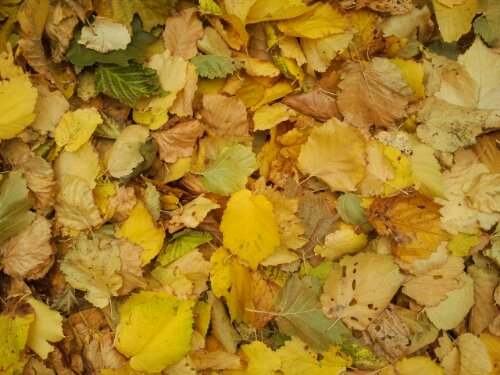
Here’s an interesting herb in a tiny spot. I think it’s Wild Parsnip (Pastinaca sativa). If it is the root would theoretically be edible but the leaves are certainly not.
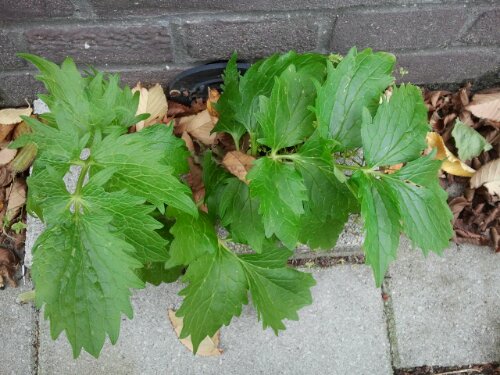
A beautiful edible and medicinal Rose, still in bloom, at the end of the street I live in.
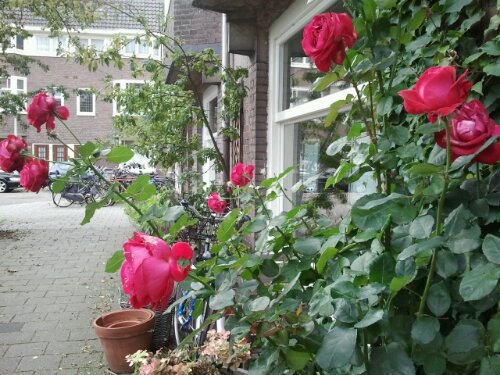
Another, now covered in maturing hips.
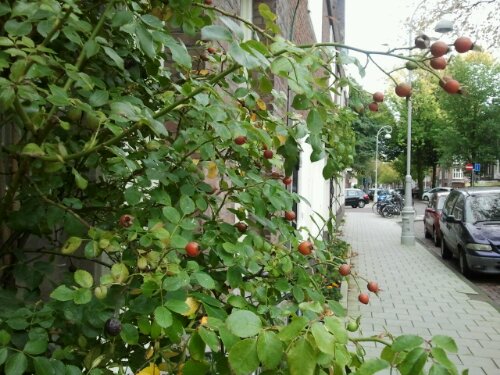
So many plants continue to bloom at the moment. There is so much to collect or forage if it’s wanted (and clean).

Today on a walk to the local swimming pool we found a lovely stand of Rose bushes which are still partly in flower. I harvested a handful to their into an old Indian ginger tonic recipe. It’s very simple and we’ll look at it on the Exotic herbs workshop on 14th October.
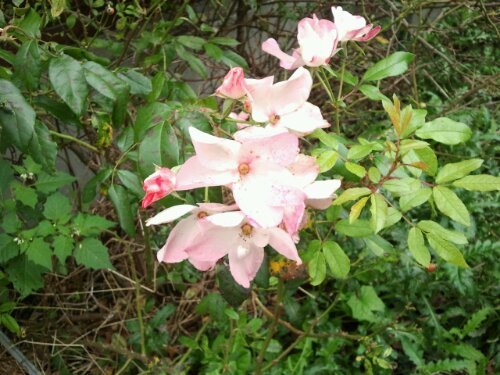
In almost every place I turned this morning, there were Gallant Soldiers growing. Now is a good time to harvest, dry and store this little herb for use, especially in potato dishes, through the winter. See day 154, for some background on the herb and a link to a traditional Colombian recipe which requires this South American herb.
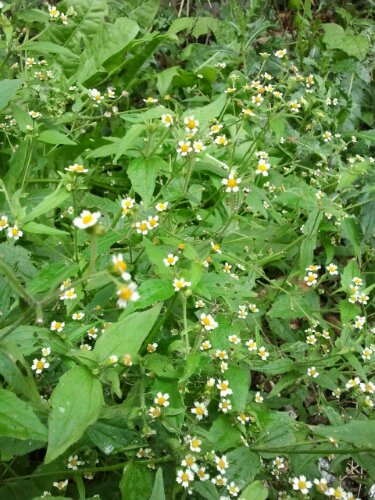

Thanks to the watertolerant group who joined me to herb walk in Sarphatipark today. We found lots of useful herbs and also interesting park workers who told us how the park is maintained by a dynamic group of volunteers and is trying innovative edible approaches to eradicate Japanese knotweed. Above is a park warden, pictured by the enormous Jerusalem artichokes which are being used to keep knotweed at bay. When the invasive plant is removed, the ground can quickly turn into a home for other unwelcome invaders or can see the return of knotweed. Using Jerusalem artichoke, another rapidly growing and spreading plant, can provide tasty tubers and quash the knotweed. So far so good!
I was also reassured to learn that the Ginkgo trees I’m so fond of in parts of Our Zuid are indeed female and yield plentiful Ginkgo nuts. Amsterdam is fortunate to have such edible plant loving folk in its green spaces team.

The plants I remember finding today are listed as tags to this entry. The spreading soft leaved plant which looked quite like Agrimony but wasn’t, was indeed a cinqefoil, called Silverweed previously called (Potentilla anserina) but now reclassified as Argentina anserina . It is shown above and it is edible. If you were on the walk and can remember other plants which I have missed from the tag list then please let me know.
Thanks again to everyone who joined me. It was a real pleasure to walk around with you. If you signed up but were not brave enough for the wet weather, remember there are always trees to shelter under next time 🙂

We filled our pockets with small, sour, fallen apples in the park today. We met an interesting lady with her dog, who told us about eating Walnut leaves, Hazelnut foragers and Honingclaver (literally Honey clover, Sweet Clover, Melilotus spp.). It’s fine to eat Sweet clover in small amounts but as you’ll read in the link above, it can interact with some blood thinning drugs and no one should eat too much of this plant.
Today’s photos:
Firstly, Ground elder (Aegopodium podograria) springing up in the rain soaked, just mowed outer verges of the park. A welcome sight, I love eating this plant and much of it looks quite stale in the other areas of the park.
Next up, Burdock flowers. As mentioned before, the second year plants flower and are not useful really. But use this sight in the urban wild to help you find first year plants perhaps.
Next a beautiful Rose, growing next to Frankendael Huis. So beautiful ans so many ways to eat them.
Here’s fragrant, digestive system soother Meadowsweet (Filipendula ulmaria). Please see the day 72 posting for further details and links.
Here’s a plant growing in the pond behind Frankendael huis which I spotted on the recent Greenpeace walks in Amsterdamse Bos. It is known as Gypsywort in Britaian and Bugelweed in the US (Lycopus europaeus). I still need to learn it’s uses but am pleased to have found it in Frankendael today.

Here is a very large, sprawling and Poisonous White Bryony (Bryonia alba), making itself at home over a big old Yew tree (Taxus baccata), also Poisonous and steeped in folklore, mainy to do with the dead.

Do you remeber that ploughed up strip of parkland, next to Restaurant de Kas? Well this is how some of it looks today. It seems to have been sewed with a wildflower mixture and it has begun to look quite beautiful.


I harvested a little Russian Comfrey today, to make a healing foot ointment. The plant is still in flower but the leaves will stay contain many of the active constituents. Also plucked for the table were a small number of Daisy flowers, some Ground Elder, a little Garlic Mustard and a few pretty Pelargonium flowers. The Ground Elder itself is still on top form for foraging although it is starting to become quite dirty in some locations, due to bird droppings and general honey dew dripping from aphids and ants in the trees above. So I would say that by now it is just past it’s best and I need to focuss my forager’s attention elsewhere.
Here are today’s photos:

Here is a White Dead Nettle, setting seed alongside the Middenweg and the park. I think you can quite clearly see how the flower and now seed clusters encircle the square Labiate family stem, quite unlike the unrelated but often mistaken Stinging Nettle. Both plants are edible.

Above is German chamomile (Matricaria chamomilla) growing close to the White Dead Nettle.

Above is Brassica rapa Wild Turnip. It smells of cabbage when picked and the flower heads remind me of broccoli. It was growing close to a patch of very young Fat Hen (Lambs quarters) but both were unfortunately in a bit of a dirty location so not for the plate tonight.ill certainly keep my eyes open for both tomorrow though as they are perfectly in season at present and make very good eating when cooked. All parts of Wild Turnip are edible and tasty.
I was also very pleased to spot some Calamints in flower for the first time this year. Photos of those tomorrow hopefully.


I picked a small pile of Elderflowers today, from along the outer Hugo de Vrieslaan edge of the park. The resident bugs are now crawling out of the flowers. I am about to get going with the Elderberry Delight recipe in the River Cottage Hedgerow Handbook. You will find the book and hence the recipe via my Books page. So before the flowers are ready for the pot, here are my few photos of today’s edibles in this part of Amsterdam:

Above is Greater Celendine (Chelidonium majus), still growing and flowering useful but not one for the pot. This is a poisonous plant but the bright orange juice within the stems can be helpful to dissolve warts.

Here’s a pretty and no doubt tasty cultivated, scented Rose. It grows on a house which borders the park. Not one to harvest of course but there are plenty more like this in town at the moment.

Above, lovely and tasty Wild Lovage. This makes very good eating and although another member of the troublesome carrot/parsnip/hemlock family, the leaves are quite different from its relatives and, with a field guide, very easy to identify. Just a leaflet or two will add a lovely flavour to cooking.

Here is a first for my 365 Frankendael Project – Fat Hen (Chenopodium alba). I am very pleased to find it, close to one of the Frankendael bus stops in some neglected land. In fact growing alongside another lover of neglected places – Mugwort. I harvested some of this one for this evening’s meal and my cat is having a good chew on a leaf at present. He seems to find it quite agreeable. Fat Hen makes great eating and is a weed which does very well on fertile soil, such as on allotments. Generally gardeners dig it up and dispose of it. I suggest they give washing and cooking it a try. Lots of Fat Hen recipes are available online and in foraging books.
If you would like to join me for a walk around the richest parts of this park, then why not sign up for my next guided walk on Sunday 15th July?

Today, Sameena from the Meetup group joined Livvy and I, on day 23 of our herb seeking mission. We saw several beautiful herbs, not least Garlic mustard, Geranium, Horsetail, the beautiful Lime trees with their glutinous leaves and Comfrey which the local bees were going crazy for.

Afterwards I found borage and wild rose in flower, both for the first time this year – a real treat! If you fancy harvesting either please remember that borage is an annual so if you take the flowers there won’t be a plant there next year and vitamin C rich Rosehips only form when Roses are fertilised by insects and allowed to develop unhindered all the way into autumn.

Above, Borage (Borago officinalis), mixed in with some Sweet cicely and Dead nettle. The small blue flowers are the easiest feature to help you distinguish this plant, it also has very hairy foliage. An alternative name for it is the Cucumber herb or plant, that’s because it tastes like cucumber! It makes a welcome addition to salads and it has uses in skin care.